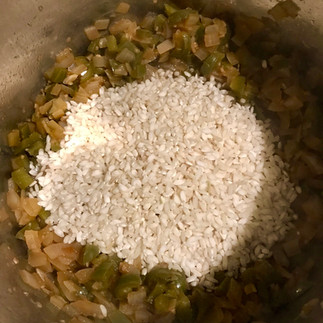Zero-fat seafood risotto with lemon
- Hobbychef

- Jan 23, 2024
- 7 min read
Updated: Jan 23, 2024
A delicious combination of citrus freshness and green vegetables with a filling satisfaction to warm you up in winter, this zero-fat seafood risotto with lemon, basil, peas and green bell peppers won't mess up any New Year's resolutions regarding fat intake.

Grain not gain
Continuing my post-operative dietary journey, I've turned my attention to another of the staples of my kitchen: risotto. The version I'm doing here is not the utterly fat-free version—though it can be done; I've tested it—but keeps fat content between just over or just under 3g per serving, depending on whether you divide these quantities between 2 or 3 diners.
You can cook it with arborio or carnaroli risotto rice. I'm a vociferous advocate of carnaroli because it's the naturally creamiest of risotto rices, reducing the need for those calorific bomba (parmesan and butter balls) in the final stages, not that they're needed here given that traditional Italian cooking rarely uses cheese in seafood and fish dishes. However, on this occasion I was out of carnaroli and cooked it with arborio and I was surprised at how creamy it was. Perhaps it's the slightly altered cooking method.
Similarly, while I'm equally vocal about the atrocities committed by chefs with their so-called "wet risotto" that only proves they don't know their risi from their bisi, my gut instinct was to cook this one to remain a little more moist than I usually would with risotto. And that definitely paid off too.
The white wine in this dish is not optional—remember, all the alcohol in the wine cooks off if you're worried about "dry January"—unless you can find a viable alternative. Since this dish uses practically no olive oil, it's key to both cooking the onions and giving the dish the great flavour that means no one can tell that it has practically no fat in it. The only alternative I can imagine working is white wine vinegar, but I haven't tested that version.
With this cooking method, I suggest you do the first stages of the onions and the seafood before starting the risotto itself. As with most near-zero fat cooking, the biggest risk is ingredients sticking and burning and once you start the risotto, it's going to demand almost constant attention until it's ready.
Note that I'm not doing it as a typical "one pot" risotto. There's two reasons for this. Firstly, this method of cooking the onions really does make a difference. And, secondly, unless you are certain of your timings, adding the raw seafood directly to the pot runs the risk of it being overcooked if the rice isn't ready when it is. This way affords more control.
Still on the topic of seafood, you can go for lovely, fancy fresh stuff or do as I am here, using a defrosted bog standard supermarket, responsibly sourced frozen seafood mix of king prawns, shelled mussels and calamari rings. Yes, I would probably fancy it up with mussels still in their shells if I were cooking it for someone else.
If you want to go more traditional, you can use fish stock instead of vegetable stock, but this can turn it too "fishy". I've opted for the hack I use for seafood risotto, even when not cooking zero-fat versions of risotto: vegetable stock and Worcestershire sauce, which is made with anchovies. This combination gives a suitable base to the seafood without the "fishiness". It's also great as an alternative to oil when sautéing the onions.
If going for the 100% zero-fat version, follow the same cooking method with a minor difference: cook the garlic in a little lemon juice and white wine before adding the onions as detailed in the steps below.
This recipe feeds two to three adults. You can work out the quantities to cook for more diners.
Shopping list
The zero-fat seafood risotto with lemon
1 cup of carnaroli rice (or any other good risotto rice, more options here)
Approx. 200g of raw seafood (e.g. mussels, king prawns, calamari), fresh or frozen
3 or 4 cloves garlic, finely chopped or finely grated
1 large brown onion, cubed (or equivalent quantity)
1 vegetable stock cube or jelly, diluted in 500ml boiling water
1 cup green peas, frozen or fresh
A generous clutch of fresh basil
1 fresh green bell pepper, roughly cubed
Salt and black pepper to taste
½ tbspn virgin olive oil
The juice and zest of 2 fresh lemons
3 tbspns Worcestershire sauce
1 large glass of white wine (250ml)
The salad
Approx. 10 baby plum tomatoes, quartered
Approx. ⅓ cucumber, cut in half vertically then sliced
1 small brown onion, thinly sliced and separated into rings
Approx. 4 tbspns of 0% fat Greek-style yoghurt
Approx. 3 tbspns red wine vinegar (or balsamic vinegar)
A little of the fresh lemon zest
Black pepper to taste
Cooking Method
The zero-fat seafood risotto with lemon
Heat a non-stick frying pan on a high heat, adding ¼ tspn of chopped garlic. The garlic isn't really an ingredient here: it's an alarm device. As soon as the garlic begins to sizzle in the dry pan, add your seafood and gently stir as it begins to cook. Don't react too soon: even if it looks like it could burn, after a minute or so, it will release juices. As soon as it does, add half of the juice and pulp of one of the lemons and a dash of the white wine, still gently stirring every now and again. Seafood cooks very quickly on a high heat and you are more at risk of overcooking it than it burning. Use the prawns as your guide. When they begin to turn pink, when they're almost cooked, remove the pan from the heat and put aside, marinading in the liquor
Place the chopped onion and green bell pepper in a microwave dish. Add the juice and pulp of 1 lemon and 2 tbspns Worcestershire sauce. Stir, cover and microwave on a high power (900W) for 4mins, stirring halfway through. Then allow to rest
In a large pot with a lid, add ½ tbspn virgin olive oil. Add the garlic to the section of the pot where the oil is most concentrated and heat on a medium-high heat. As soon as it begins to sizzle, stir to ensure it doesn't stick. When it turns golden, add the onions, green bell pepper and any juices from the microwave container. Stir vigorously, coating them with whatever oil remnants remain in the pot. These are likely to be absorbed almost immediately (if it goes too fast and they begin to stick, add a dab of stock, just enough to stave off sticking). Add the remainder of the lemon juice and season with pepper and salt (if using). The lemon juice will also cook off quickly, with a slight caramelising effect
Add half of the white wine and allow it to cook off, stirring nearly constantly. Then add the remainder of the wine and about 4tbsns of the stock. Cover and sweat for 3 to 4 mins. Increase the heat to high. If the liquid hasn't cooked off by this time, it soon will
When the liquid has cooked off enough i.e. the ingredients still have a semblance of protective moisture, but you can push them to the sides of the pot without there being any liquid at the centre, add the unwashed rice and seal (tostatura). You can learn more about this key step here
However, remember that there is practically no oil assisting the toasting, so stir the contents together steadily. Once the rice is sealed, add the remainder of your stock and the rest of the Worcestshire sauce. Stir, and bring to the boil. Boil vigorously for 6 to 7 mins, stirring regularly. Without the usual amounts of oil, these ingredients are likely to stick much more quickly
Once the liquid begins to cook off, remove the lid and reduce the heat, adding a little additional boiling water if the liquid has cooked off too quickly. Add the basil leave to the top of the pot. Simmer for a further 5 or 5mins, stirring as needed. From this stage onwards, you'll need to stir the risotto continuously while it reduces and add any necessary boiling water. It's fairly intuitive, but don't add too much at a time.
Add the peas. Exactly when you add them will depend on whether using fresh or frozen. For example, if using fresh, add the peas about 4mins before you expect the risotto to be cooked. For frozen, about 6mins before.
When the peas have cooked for a few minutes, at the spinach and pea shoots in turn, about 3 to 4mins before your dish is done.
When the rice is cooked, add the seafood and all of the juices from the pan. Add half of the lemon zest and gently stir the pot, so that all of the ingredients and juices are thoroughly integrated. Cook for no longer than 1min
Remove from the heat and allow to rest, covered, for a few minutes
Plate, garnish with with basil leaves and take to table, serving with the salad
The salad
Mix the tomatoes, cucumber and onion in individual bowls or a salad bowl
For the dressing, mix the yoghurt, vinegar and black pepper to taste in a cup or bowl
Dress the salad, garnish with a little lemon zest and take to table

Alternatives
This dish is pescatarian but is easily made vegetarian or vegan by using mushroom ketchup in lieu of the Worcestershire sauce and increasing the quantities of green bell pepper and peas.
Sadly carnivores, you can't have it all. There isn't a suitable meat that keeps this dish at its ultra-low circa 3g of fat content. If it's the risotto rather than the zero-fat aspect that's caught your attention, why not try this recipe.
Pairings
I'm still happily on the wagon during my post-operative recovery, so I paired it with sparkling water infused with basil and lemon pulp, which was a great match.
But that doesn't mean I can't be imaginative. Naturally, one thinks primarily of white wines for this dish. The sun-drenched nature of Sicilian catarattos immediately came to mind, more specifically this Ca' di Ponti Catarratto 2022, a perfectly worthy workaday wine that has flashes of peach and fennel that provide a welcome counterpoint to the more obvious lemon notes common in catarratos, including this one. Or, you could head straight for Vermentino Colli di Luni 'Etichetta Grigia' Lunae Bosoni 2021, which is a great pairing with seafood but still won't break the bank.
And, of course it's great with beer. One that I remember working really well with seafood risotto is Birra del Borgo Lisa, a jaunty Italian lager with the perfect level of bitterness and a vague hint of citrus, probably because it's brewed from orange peel combined with cappelli wheat.



















Comments